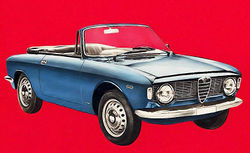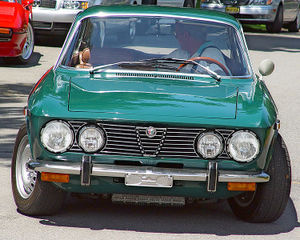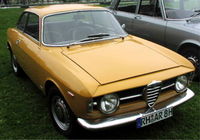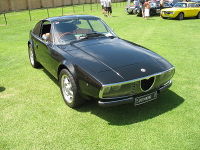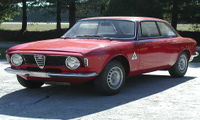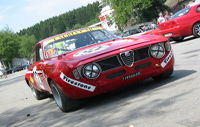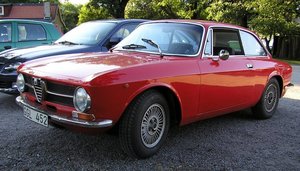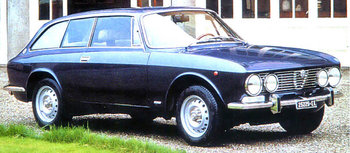Difference between revisions of "Alfa Romeo Giulia"
m |
m |
||
| (34 intermediate revisions by the same user not shown) | |||
| Line 1: | Line 1: | ||
| − | [[Image: | + | {{X}} |
| − | [[Image: | + | {| border=1 cellspacing=3 cellpadding=4 style="float:right; margin:0 0 .5em 1em; width:250px; background:#505050; border-collapse:collapse; border:1px solid #999; font-size:83%; line-height:1.5; " summary="Infobox Automobile" |
| − | [[Image: | + | |- style="text-align:center; background:#505050;" |
| − | [[Image: | + | | colspan=2 style="padding:0; background:#333333; color:#fff; border-bottom:1px solid #999;" |[[Image:Alfa Romeo GTJ1.jpg|250px|Alfa Romeo GT Junior]] ''Alfa Romeo GT 1300 Junior, early model'' |
| + | |- style="color:#fff; background:darkred; font-size:larger;" | ||
| + | ! colspan=2 |'''Alfa Romeo 105/115 Series Coupé''' | ||
| + | |- | ||
| + | |Manufacturer || [[Alfa Romeo]] | ||
| + | |- | ||
| + | |Production || 1963–1977 | ||
| + | |- | ||
| + | |Predecessor || [[Alfa Romeo Giulietta|Alfa Romeo Giulietta Coupé]] | ||
| + | |- | ||
| + | |Successor || [[Alfa Romeo Alfetta#GT, GTV and GTV6|Alfa Romeo Alfetta GT, GTV & GTV6]] | ||
| + | |- | ||
| + | |Class || [[Sports car|Sports Car]] | ||
| + | |- | ||
| + | |Body style || [[2 plus 2|2+2]] [[Coupé]]<br> [[2 plus 2|2+2]] [[Cabriolet (automobile)|Cabriolet]] | ||
| + | |- | ||
| + | |Layout || [[FR layout]] | ||
| + | |- | ||
| + | |Engine || [[Straight-4]] | ||
| + | |- | ||
| + | |Transmission || 5-speed manual | ||
| + | |- | ||
| + | |Fuel capacity || | ||
| + | |- | ||
| + | |Assembly || [[Italy]] (1965-1977)<br>Rosslyn plant, [[South Africa]] | ||
| + | |- | ||
| + | |Related || [[Alfa Romeo Giulia|Alfa Romeo Giulia Saloon]] | ||
| + | |- | ||
| + | |Similar || | ||
| + | |- | ||
| + | |Designer || [[Bertone]] | ||
| + | |} | ||
| + | |||
| + | |||
| + | The '''Alfa Romeo 105/115 series ''[[Coupé]]s''''' were a range of cars made by the [[Italy|Italian]] manufacturer [[Alfa Romeo]] from 1963 until 1977. They were the successors to the celebrated [[Alfa Romeo Giulietta|Giulietta Sprint]] coupé and used a shortened [[floorpan]] from the [[Alfa Romeo Giulia|Giulia]] [[Sedan (car)|Berlina car]]. These appealing cars were made in a wide variety of models over a period of 13 years, so they provide a lot of material for study by Alfa Romeo enthusiasts. | ||
| + | |||
| + | |||
| + | == Bodywork == | ||
| + | |||
| + | The basic [[Car body style|body shape]] shared by all models was designed by [[Giorgetto Giugiaro]] for [[Bertone]]. It was one of his first major projects for Bertone, and borrowed heavily from his earlier design for the [[Alfa Romeo 2600|Alfa Romeo 2000 Sprint/2600 Sprint]]. The balance of glass and metal, the influence of the shape of the front and rear glass on the shape of the cabin, and the flat grille with incorporated headlamps were groundbreaking styling features for the era. | ||
| + | |||
| + | A limited production (1000 units) [[convertible]], the Giulia Sprint GTC, was a modification from the standard car by [[Carrozzeria Touring|Touring]] of Milan, offered as a catalogue model by Alfa Romeo called the Giulia Sprint GTC. | ||
| + | |||
| + | A small number of the [[Alfa_Romeo_Sprint_GT_(Veloce)#GT Junior models|GT Junior models]] were also built with a very different, aerodynamic two-seater coupe body designed by [[Ercole Spada]] for [[Zagato]] of Milan. These too were offered by Alfa Romeo as catalogue models, as the GT 1300 Junior Zagato and later GT 1600 Junior Zagato. | ||
| + | |||
| + | |||
| + | == Mechanical features == | ||
| + | |||
| + | All models feature the four cylinder, all-light-alloy [[Alfa Romeo Twin Cam engine]] in various cubic capacities from 1290 cc to 1962 cc, all with two valves per cylinder. All versions of this engine fitted to the 105 series coupes featured [[carburator|twin carburettors]], except for US market 1750 GTV and 2000 GTV cars which were fitted with [[fuel injection]]. Competition models featured cylinder heads with twin spark plugs. Common to all models was also a 5-speed [[manual transmission]] and disc brakes on all four wheels. The rear suspension uses a beam axle with coil springs. [[Air conditioning]] and a [[limited slip differential|limited slip rear differential]] were optional on the later models. | ||
| + | |||
| + | [[Image:1972 Alfa GTV1.jpg|thumb|right|250px|1972 GTV at [http://www.woiow.com Wheels Of Italy]]] | ||
| + | |||
| + | |||
| + | == Models == | ||
| + | {| border=1 cellspacing=3 cellpadding=4 style="float:center; margin:0 0 .5em 1em; width:400px; background:#505050; border-collapse:collapse; border:1px solid #999; font-size:83%; line-height:1.5; " summary="Infobox Automobile" | ||
| + | |- style="text-align:center; background:#505050;" | ||
| + | |- tr BGCOLOR=darkred | ||
| + | !style="background:#darkred" align="center" valign="middle" |<font color=>'''Version''' | ||
| + | !style="background:#darkred" align="center" valign="middle" | <font color=>'''Years of production''' | ||
| + | !style="background:#darkred" align="center" valign="middle" | <font color=>'''Units produced''' | ||
| + | |----- | ||
| + | |'''Sprint GT''' || from 1963 to 1966 || 21,542 | ||
| + | |----- | ||
| + | |'''Sprint GTC''' || from 1964 to 1966 || 1,000 | ||
| + | |----- | ||
| + | |'''Sprint GTV''' || from 1965 to 1968 || 14,240 | ||
| + | |----- | ||
| + | |'''1750 GTV''' || from 1968 to 1973 || 44,269 | ||
| + | |----- | ||
| + | |'''2000 GTV''' || from 1971 to 1976 || 37,459 | ||
| + | |----- | ||
| + | |'''GT 1300 Junior''' || from 1965 to 1977 || 91,195 | ||
| + | |----- | ||
| + | |'''GT 1600 Junior''' || from 1972 to 1976 || 14,299 | ||
| + | |----- | ||
| + | |} | ||
| + | |||
| + | |||
| + | The 105 series coupés featured the GT ([[Gran Turismo (automobile)|Gran Turismo]]) model description, which was common to all models in one form or another. | ||
| + | |||
| + | The various different models in this range can be considered in two broad categories. | ||
| + | |||
| + | On one hand were the various Gran Turismos and Gran Turismo Veloces (veloce is Italian for "fast"). These were meant to be the most sporting cars in the Alfa Romeo range and sold very well to enthusiastic motorists around the world. The first model available was the Giulia Sprint GT (1963) which evolved into the Giulia Sprint GT Veloce (1965), the 1750 GTV (1968) and the 2000 GTV (1972-1976), with engines increasing in cubic capacity from 1570 cc (Giulia Sprint GT/GTV) through 1779 cc (1750 GTV) to 1962 cc (2000 GTV). A limited production (1000 units) [[convertible]], the Giulia Sprint GTC, was based on the Giulia Sprint GT, modified by Touring of Milan. It was only made over two years from 1964 to 1966. | ||
| + | |||
| + | On the other hand was the GT Junior range, which featured engines with smaller cubic capacities. GT Juniors sold in great numbers to people who wanted a sporting, stylish car that handled well, but either did not require the maximum in engine power, or could not afford the taxation on larger engine capacities in some markets - most notably, Alfa Romeo's home Italian market. Junior models began with the first GT 1300 Junior in 1966. The GT 1300 Junior continued until 1976 with the 1290 cc engine and various modifications incorporating features from the evolution of the GT's and GTV's. From 1972 a GT 1600 Junior model was also available, with the 1570 cc engine. | ||
| + | |||
| + | The 1300 Junior and 1600 Junior also became available with a very different, aerodynamic two-seater coupe body designed by [[Ercole Spada]] for [[Zagato]] of Milan. These models were the GT 1300 Junior Zagato and GT 1600 Junior Zagato. | ||
| + | |||
| + | Both categories were used to derive [[Alfa Romeo GTA|GTA]] ("Allegerita", or "lightened") models, which were specifically intended for competition [[homologation]] in their respective engine size classes. The GTA's featured extensive modifications for racing, so they were priced much higher than the standard models and sold in much smaller numbers. Practically all GTA's made were used in competition, where they had a long and successful history in various classes and category. These models included the [[Alfa Romeo GTA|Giulia Sprint GTA]], [[Alfa Romeo GTA|GTA 1300 Junior]], and [[Alfa Romeo GTA|GTAm]] (a much evolved version of the GTA built by [[Autodelta]]). | ||
| + | |||
| + | Although not commonly thought of as a 105 Series coupe variant, the [[Alfa Romeo Montreal]] used a strengthened and slightly modified 105 series floorpan and suspension. | ||
| + | |||
| + | |||
| + | == GT and GTV models == | ||
| + | === Giulia Sprint GT (1963–1966) === | ||
| + | '''Tipo: 105.02. Motore: 00502.''' | ||
| + | |||
| + | {| border=1 cellspacing=3 cellpadding=4 style="float:right; margin:0 0 .5em 1em; width:250px; background:#505050; border-collapse:collapse; border:1px solid #999; font-size:83%; line-height:1.5; " summary="Infobox Automobile" | ||
| + | |- style="text-align:center; background:#505050;" | ||
| + | | colspan=2 style="padding:0; background:#333333; color:#fff; border-bottom:1px solid #999;" |[[Image:Alfa romeo giulia sprint gt 16001.jpg|250px]] | ||
| + | |- style="color:#fff; background:darkred; font-size:larger;" | ||
| + | ! colspan=2 |'''Giulia Sprint GT''' | ||
| + | |- | ||
| + | |Manufacturer || [[Alfa Romeo]] | ||
| + | |- | ||
| + | |Production || 1963–1966 | ||
| + | |- | ||
| + | |Predecessor || | ||
| + | |- | ||
| + | |Successor || | ||
| + | |- | ||
| + | |Class || | ||
| + | |- | ||
| + | |Body style || [[2 plus 2|2+2]] [[coupé]] | ||
| + | |- | ||
| + | |Layout || | ||
| + | |- | ||
| + | |Engine || 1570 cc dohc [[straight-4]] | ||
| + | |- | ||
| + | |Weight || 948 kg | ||
| + | |- | ||
| + | |Fuel capacity || | ||
| + | |- | ||
| + | |Assembly || | ||
| + | |} | ||
| + | |||
| + | |||
| + | |||
| + | The Giulia Sprint GT was the first model introduced, and was manufactured from 1963 to 1966. It featured the original form of the Bertone body with the scalina (stepped) or "step front" (the leading edge of the hood/bonnet sat 1/4 an inch above the nose of the car). It can be most easily distinguished from other models by the following features: | ||
| + | |||
| + | * Badging: chrome script reading "Giulia Sprint GT" on bootlid, one round Alfa Romeo badge on the grille heart, Bertone badges behind the front wheelarches. | ||
| + | * Flat, [[Chrome plating|chrome]] grille featuring a plain rectangular mesh with no bars. | ||
| + | * Single-piece chrome [[Bumper (automobile)|bumpers]] | ||
| + | * Dashboard with a flat, tilted panel finished in grey crackle. | ||
| + | |||
| + | The car was fitted with the 1570 cc [[engine displacement|displacement]] version of the engine (78 mm bore x 82 mm stroke, 6.38 L oil sump, 7.41 L radiator). Dunlop [[disc brakes]] were fitted all around. The rear brakes featured an unusual arrangement with the slave cylinders mounted on the axle tubes, operating the calipers by a system of levers and cranks. 31,955 Sprint GTs were produced. | ||
| + | {{-}} | ||
| + | |||
| + | ===Giulia Sprint GTC (1964-1966) === | ||
| + | '''Tipo: 105.25. Right hand drive tipo: 105.29. Motore: 00502.''' | ||
| + | |||
| + | {| border=1 cellspacing=3 cellpadding=4 style="float:right; margin:0 0 .5em 1em; width:250px; background:#505050; border-collapse:collapse; border:1px solid #999; font-size:83%; line-height:1.5; " summary="Infobox Automobile" | ||
| + | |- style="text-align:center; background:#505050;" | ||
| + | | colspan=2 style="padding:0; background:#333333; color:#fff; border-bottom:1px solid #999;" |[[File:Alfa Romeo Giulia Sprint GTC.jpg|250px]] | ||
| + | |- style="color:#fff; background:darkred; font-size:larger;" | ||
| + | ! colspan=2 |'''Giulia Sprint GTC''' | ||
| + | |- | ||
| + | |Manufacturer || [[Alfa Romeo]] | ||
| + | |- | ||
| + | |Production || 1964–1966<br>around 1000 produced | ||
| + | |- | ||
| + | |Predecessor || | ||
| + | |- | ||
| + | |Successor || | ||
| + | |- | ||
| + | |Class || | ||
| + | |- | ||
| + | |Body style || [[2 plus 2|2+2]] [[Cabriolet (automobile)|cabriolet]] | ||
| + | |- | ||
| + | |Layout || | ||
| + | |- | ||
| + | |Engine || 1570 cc dohc [[straight-4]] | ||
| + | |- | ||
| + | |Transmission || | ||
| + | |- | ||
| + | |Wheelbase || | ||
| + | |- | ||
| + | |Length || 4080 mm | ||
| + | |- | ||
| + | |Width || 1580 mm | ||
| + | |- | ||
| + | |Height || 1315 mm | ||
| + | |- | ||
| + | |Fuel capacity || | ||
| + | |- | ||
| + | |Assembly || | ||
| + | |- | ||
| + | |Weight || 905 kg | ||
| + | |} | ||
| + | [[File:Alfa Romeo Giulia GTC.jpg|thumb|left|250px|'''Alfa Romeo Giulia GTC''']] | ||
| + | |||
| + | |||
| + | The Giulia Sprint GTC was a Cabriolet version produced in very limited numbers making them rare today with a total production of 1000 in right and left hand drive versions. The car was based on the Giulia Sprint GT, with the cabriolet modification carried out by Touring of Milan. Besides the cabriolet top, a distinguishing feature is the dashboard finished in black instead of grey crackle. The model was badged with a script reading "Giulia Sprint GTC" on the bootlid. | ||
| + | |||
| + | To restore some of the bodyshell rigidity lost by removing the fixed roof and pillars, Carrozzeria Touring added reinforcement to several areas of the bodyshell. Through the production life of the model, several modifications to the reinforcement applied were made by Touring, apparently in an effort to improve the stiffening achieved. | ||
| + | |||
| + | Carrozzeria Touring was in financial trouble when the Giulia Spring GTC went into production. The company went out of business shortly after production of this model ended. | ||
| + | {{-}} | ||
| + | |||
| + | ===Giulia Sprint GT Veloce (1965-1968) === | ||
| + | '''Tipo: 105.36. Right hand drive tipo: 105.37. Motore: 00536.''' | ||
| + | |||
| + | {| border=1 cellspacing=3 cellpadding=4 style="float:right; margin:0 0 .5em 1em; width:250px; background:#505050; border-collapse:collapse; border:1px solid #999; font-size:83%; line-height:1.5; " summary="Infobox Automobile" | ||
| + | |- style="text-align:center; background:#505050;" | ||
| + | | colspan=2 style="padding:0; background:#333333; color:#fff; border-bottom:1px solid #999;" |[[Image:1967 Giulia Sprint GT Veloce1.jpg|250px|Giulia Sprint GT Veloce]] | ||
| + | |- style="color:#fff; background:darkred; font-size:larger;" | ||
| + | ! colspan=2 |'''Giulia Sprint GT Veloce (GTV)''' | ||
| + | |- | ||
| + | |Manufacturer || [[Alfa Romeo]] | ||
| + | |- | ||
| + | |Production || 1965–1968 | ||
| + | |- | ||
| + | |Predecessor || Giulia Sprint GT | ||
| + | |- | ||
| + | |Successor || 1750 GTV | ||
| + | |- | ||
| + | |Class || | ||
| + | |- | ||
| + | |Body style || [[2 plus 2|2+2]] [[coupé]] | ||
| + | |- | ||
| + | |Layout || | ||
| + | |- | ||
| + | |Engine || 1570 cc dohc [[straight-4]] | ||
| + | |- | ||
| + | |Transmission || 5-speed synchromesh | ||
| + | |- | ||
| + | |Wheelbase || | ||
| + | |- | ||
| + | |Length || 4089 mm | ||
| + | |- | ||
| + | |Width || 1575 mm | ||
| + | |- | ||
| + | |Height || 1321 mm | ||
| + | |- | ||
| + | |Fuel capacity || | ||
| + | |- | ||
| + | |Assembly || | ||
| + | |- | ||
| + | |Weight || 1012 kg | ||
| + | |} | ||
| + | |||
| + | |||
| + | |||
| + | The Giulia Sprint GT Veloce was very similar to the original Giulia Sprint GT. It featured minor modifications to the engine, providing just 3 bhp more power, but significantly improved torque. It can be most easily distinguished from other models by the following features: | ||
| + | * Badging as per Giulia Sprint GT, with two additions: Round enamel badges on the C-pillar with a Green quadrifoglio (cloverleaf) on an ivory background, and chrome "Veloce" script on rear panel. | ||
| + | * Grille with black mesh and 3 horizontal chrome bars. | ||
| + | * Dashboard with tilted flat panel as on the Giulia Sprint GT but with imitation woodgrain instead of grey crackle finish (first seen on the GT 1300 Junior). | ||
| + | * Front seats revised to a mild "bucket" design. | ||
| + | * Grille heart has 7 bars instead of 6. | ||
| + | * Stainless steel bumpers, as opposed to the chromed mild steel bumpers on the Giulia Sprint GT. The bumpers are the same shape, but made in two pieces (front) and three pieces (rear) with small covers hiding the joining rivets. | ||
| + | |||
| + | Early Giulia Sprint GT Veloces featured the same Dunlop disk brake system as the Giulia Sprint GT. Later cars replaced this with the ATE disk brakes as pioneered on the GT 1300 Junior in 1966. The ATE brakes featured an interesting and more effective handbrake system on the rear brakes, which incorporated drum brakes inside the disk castings. | ||
| + | |||
| + | A total of 14,240 Giulia Sprint GT Veloces were made before production finished. | ||
| + | |||
| + | |||
| + | {| border=1 cellspacing=3 cellpadding=4 style="float:left; margin:0 0 .5em 1em; width:300px; background:#505050; border-collapse:collapse; border:1px solid #999; font-size:83%; line-height:1.5; " summary="Infobox Automobile" | ||
| + | |- style="text-align:center; background:#505050;" | ||
| + | | colspan=2 style="padding:0; background:#333333; color:#fff; border-bottom:1px solid #999;" |<videoflash>pQhN44CI3QQ|300|250</videoflash> | ||
| + | |- style="color:#fff; background:darkred; font-size:larger;" | ||
| + | ! colspan=2 |'''Alfa Romeo Giulia GTA Junior Gr.5 Racing''' | ||
| + | |}{{-}} | ||
| + | |||
| + | |||
| + | === 1750 GT Veloce (1967-1971) === | ||
| + | '''Tipo: 105.44. Right hand drive tipo: 105.45. Motore: 00548''' | ||
| + | |||
| + | '''U.S. tipo: 105.51. Motore: 00571.''' | ||
| + | |||
| + | {| border=1 cellspacing=3 cellpadding=4 style="float:right; margin:0 0 .5em 1em; width:250px; background:#505050; border-collapse:collapse; border:1px solid #999; font-size:83%; line-height:1.5; " summary="Infobox Automobile" | ||
| + | |- style="text-align:center; background:#505050;" | ||
| + | | colspan=2 style="padding:0; background:#333333; color:#fff; border-bottom:1px solid #999;" |[[Image:Alfa Romeo GT Veloce1.jpg|250px|Alfa Romeo Giulia GTV]] | ||
| + | |- style="color:#fff; background:darkred; font-size:larger;" | ||
| + | ! colspan=2 |'''1750 GT Veloce (GTV)''' | ||
| + | |- | ||
| + | |Production || 1967-1971 | ||
| + | |- | ||
| + | |Body style || 2-door [[coupé]] | ||
| + | |- | ||
| + | |Engine || 1779 cc dohc [[straight-4]] | ||
| + | |- | ||
| + | |Length || 4089 mm | ||
| + | |- | ||
| + | |Fuel capacity || 46L | ||
| + | |- | ||
| + | |Weight || 1038 kg | ||
| + | |- | ||
| + | |Height || 1321 mm | ||
| + | |- | ||
| + | |Width || 1575 mm | ||
| + | |- | ||
| + | |Wheelbase || 2350mm | ||
| + | |} | ||
| + | |||
| + | |||
| + | The 1750 GTV appeared in 1967 along with the [[Alfa Romeo 1750|1750 Berlina]] sedan and [[Alfa Romeo Spider|1750 Spider]]. The same type of engine was used to power all three versions; this rationalisation was a first for Alfa Romeo. | ||
| + | |||
| + | The 1750 GTV replaced the Giulia Sprint GT Veloce and introduced many updates and modifications. Most significantly, the engine capacity was increased to 1779 cc displacement (80 mm bore x 88.5 mm stroke, 6.61l oil capacity, 9.58l radiator capacity). Peak power from the engine was increased to {{convert|122|PS|kW hp|0|abbr=on}} at 5500 rpm. The stroke was lengthend from 82 to 88.5 mm over the 1600 engine, and a reduced rev limit from 7000 rpm to 6000 rpm. Maximum torque was increased to {{Auto Nm|186|0}} at 3000 rpm. A higher ratio final drive was fitted (10/41 instead of 9/41) but the same gearbox ratios were retained. The result was that, on paper, the car had only slightly improved performance compared to the Giulia Sprint GT Veloce, but on the road it was much more flexible to drive and it was easier to maintain higher average speeds for fast touring. For the United States market, the 1779 cc engine was fitted with a [[fuel injection]] system made by Alfa Romeo subsidiary [[SPICA]], to meet emission control laws that were coming into effect at the time. Carburettors were retained for other markets. | ||
| + | |||
| + | The chassis was also significantly modified. Tire size went to 165/14 from 155/15 and wheel size to 5 1/2J x 15 instead of 5J x 15, giving a wider section and slightly smaller rolling diameter. The suspension geometry was also revised, and an anti-roll bar was fitted to the rear suspension. ATE disk brakes were fitted from the outset, but with bigger front disks and calipers than the ones fitted to GT 1300 Juniors and late Giulia Sprint GT Veloces. The changes resulted in significant improvements to the handling and braking, which once again made it easier for the driver to maintain high average speeds for fast touring. | ||
| + | |||
| + | The 1750 GTV also departed significantly from the earlier cars externally. New nose styling eliminated the "stepped" hood of the Giulia Sprint GT, GTC, GTA and early GT 1300 Juniors and incorporated four headlamps. United States market 1750 GTV's also featured larger rear light clusters. Besides the chrome "1750" badge on the bootlid, there was also a round Alfa Romeo badge. Similar Quadrofoglio badges to those on the Giulia Sprint GT Veloce were fitted on C pillars, but the Quadrofoglio was coloured gold instead of green. The car also adopted the higher rear wheelarches first seen on the GT 1300 Junior. | ||
| + | |||
| + | The interior was also much modified over that of earlier cars. There was a new dashboard with large speedometer and tachometer instruments in twin binnacles closer to the driver's line of sight. The instruments were mounted at a more conventional angle, avoiding the reflections caused by the upward angled flat dash of earlier cars. Conversely, auxiliary instruments were moved to angled bezels in the centre console, further from the driver's line of sight than before. The new seats introduced adjustable headrests which merged with the top of the seat when fully down. The window winder levers, the door release levers and the quarterlight vent knobs were also restyled. | ||
| + | |||
| + | Early (Series 1) 1750 GTV's featured the same bumpers as the Giulia Sprint GT Veloce, with the front bumper modified to mount the indicator / sidelight units on the top of its corners. | ||
| + | |||
| + | The Series 2 1750 GTV of 1970 introduced other mechanical changes, including a dual circuit braking system (split front and rear, with separate servos). The brake and clutch pedals on left hand drive cars were also of an improved pendant design, instead of the earlier floor-hinged type. On right hand drive cars the floor-hinged pedals were retained, as there was no space for the pedal box behind the carburettors. Externally, the series 2 1750 GTV is identified by new, slimmer bumpers with front and rear overriders. The combined front indicator and sidelight units were now mounted to the front panel instead of the front bumper. The interior was slightly modified, with the seats retaining the same basic outline but following a simpler design. | ||
| + | |||
| + | 44,269 1750 GTVs were made before their replacement came along. | ||
| + | |||
| + | |||
| + | === 2000 GT Veloce (1971-1976) === | ||
| + | '''Tipo: 105.21. Right hand drive tipo: 105.22.''' | ||
| + | |||
| + | '''U.S. tipo: 11501. Motore: 01500.''' | ||
| + | |||
| + | {| border=1 cellspacing=3 cellpadding=4 style="float:right; margin:0 0 .5em 1em; width:250px; background:#505050; border-collapse:collapse; border:1px solid #999; font-size:83%; line-height:1.5; " summary="Infobox Automobile" | ||
| + | |- style="text-align:center; background:#505050;" | ||
| + | | colspan=2 style="padding:0; background:#333333; color:#fff; border-bottom:1px solid #999;" |[[Image:Alfa Romeo 2000 gt veloce coupe1.jpg|250px|Alfa Romeo 2000 GTV with optional "turbina" alloys]] | ||
| + | |- style="color:#fff; background:darkred; font-size:larger;" | ||
| + | ! colspan=2 |'''2000 GT Veloce (GTV)''' | ||
| + | |- | ||
| + | |Production || 1971-1976 | ||
| + | |- | ||
| + | |Body style || 2-door [[coupé]] | ||
| + | |- | ||
| + | |Engine || 1962 cc dohc [[straight-4]] | ||
| + | |- | ||
| + | |Length || 4089 mm | ||
| + | |- | ||
| + | |Fuel capacity || 52.3 L | ||
| + | |- | ||
| + | |Weight || 1028 kg | ||
| + | |- | ||
| + | |Height || 1321 mm | ||
| + | |- | ||
| + | |Width || 1575 mm | ||
| + | |- | ||
| + | |Wheelbase || 2350 mm | ||
| + | |} | ||
| + | |||
| + | |||
| + | The 2000 GTV was introduced in 1971 together with the [[Alfa Romeo 1750|2000 Berlina]] sedan and [[Alfa Romeo Spider|2000 Spider]]. The 2000 range was the replacement for the 1750 range. Once again the engine was rationalised throughout the range. The engine displacement was increased to 1962 cc with a change of the bore and stroke to 84 mm x 88.5 mm. Oil and radiator capacities remained unchanged. The engine produced 132 PS at 5500 rpm with the [[SPICA]] fuel injection, which, once again, was only fitted to cars destined for the United States market, with carburettors retained for other markets. | ||
| + | |||
| + | The interior trim was also changed, with the most notable differences being the introduction of a single instrument cluster, instead of the gauges installed in the dash panel in earlier cars. | ||
| + | |||
| + | [[Image:Alfa-Romeo-2000-GT-Veloce-Green-st1.jpg|left|thumb|The 2000 GTV is most easily distinguished by its different grille.]] | ||
| + | |||
| + | Externally the 2000 GTV is most easily distinguished by the following features: | ||
| + | |||
| + | * Grille with horizontal chrome bars, featuring protruding blocks forming the familiar Alfa heart in outline. | ||
| + | * Smaller hubcaps with exposed wheel nuts. | ||
| + | * Optional aluminium alloy wheels of the same size as the standard 5. 1/2J x 14 steel items, styled to the "turbina" design first seen on the alloy wheels of the [[Alfa Romeo Montreal]]. "Turbina" refers to the wheel's resemblance to a jet engine inlet. | ||
| + | * The larger rear light clusters first fitted to United States market 1750 GTV's were standard for all markets on the 2000 GTV. | ||
| + | |||
| + | 37,459 2000 GTVs were made before production ended. | ||
| + | {{-}} | ||
| + | |||
| + | |||
| + | == GT Junior models == | ||
| + | [[Image:MHV Alfa-Romeo GT 1300 Junior 011.jpg|200px|thumb|left|1968 GT 1300 Junior]] | ||
| + | |||
| + | |||
| + | === GT 1300 Junior (1965-1977) === | ||
| + | '''Tipo: 105.30. Right hand drive tipo: 105.31. Motore: 00530. Motore, 1974 on: 00530*S.''' | ||
| + | |||
| + | {| border=1 cellspacing=3 cellpadding=4 style="float:right; margin:0 0 .5em 1em; width:250px; background:#505050; border-collapse:collapse; border:1px solid #999; font-size:83%; line-height:1.5; " summary="Infobox Automobile" | ||
| + | |- style="text-align:center; background:#505050;" | ||
| + | | colspan=2 style="padding:0; background:#333333; color:#fff; border-bottom:1px solid #999;" |[[Image:1972alfaromeo1300gtfront1.jpg|250px|1972 GT 1300 Junior.]] | ||
| + | |- style="color:#fff; background:darkred; font-size:larger;" | ||
| + | ! colspan=2 |'''GT 1300 Junior''' | ||
| + | |- | ||
| + | |Manufacturer || [[Alfa Romeo]] | ||
| + | |- | ||
| + | |Production || 1965-1977 | ||
| + | |- | ||
| + | |Predecessor || | ||
| + | |- | ||
| + | |Successor || | ||
| + | |- | ||
| + | |Class || | ||
| + | |- | ||
| + | |Body style || [[2 plus 2|2+2]] [[coupé]] | ||
| + | |- | ||
| + | |Layout || | ||
| + | |- | ||
| + | |Engine || 1290 cc dohc [[straight-4]] | ||
| + | |- | ||
| + | |Transmission || | ||
| + | |- | ||
| + | |Wheelbase || | ||
| + | |- | ||
| + | |Length || 4080 mm | ||
| + | |- | ||
| + | |Width || 1580 mm | ||
| + | |- | ||
| + | |Height || 1310 mm | ||
| + | |- | ||
| + | |Weight || 930 kg | ||
| + | |- | ||
| + | |Fuel capacity || 46 L | ||
| + | |} | ||
| + | |||
| + | |||
| + | The GT 1300 Junior was the entry model to the Alfa Romeo coupe range. It was introduced in 1965 as the replacement for the 101 series [[Alfa Romeo Giulia|Giulia Sprint 1300]], which was the final development of the [[Alfa Romeo Giulietta|Giulietta Sprint]] series. | ||
| + | |||
| + | The GT 1300 Junior was fitted with the 1300 (1290 cc) [[Alfa Romeo Twin Cam engine|twin cam]] [[engine]] (74 mm bore x 75 mm stroke), as fitted to the Giulietta series cars, but revised for the 105 series with reduced port sizes and other modifications. The smaller engine was introduced in order to allow buyers to choose an Alfa Romeo coupe while avoiding the higher taxes on the models with larger engine capacity, especially in Alfa Romeo's home Italian market. | ||
| + | |||
| + | The performance was low-end compared to others in its [[car model|model]] line, with a total of 89 bhp. However, the GT 1300 Junior's top speed of over 100 [[miles per hour|mph]] and 0-60 mph time of 12.6 seconds were very good for a fully-appointed coupe with an engine of only 1300 cc displacement. | ||
| + | |||
| + | The GT 1300 Junior was in production for over a decade. Throughout this period it was updated by the factory, incorporating many of the same revisions applied to the larger-engined models. | ||
| + | |||
| + | The first GT 1300 Juniors produced were based on the Giulia Sprint GT, with a simpler interior. The major external identifying feature was the black grille with just one horizontal chrome bar. The same 9/41 final drive ratio was maintained, but with a shorter 5th gear ratio of 0.85, instead of 0.79 as on all the other 105 Series coupes. | ||
| + | |||
| + | Together with the [[Alfa Romeo Giulia|Giulia 1300 Ti]], the GT 1300 Junior pioneered the use of ATE disk brakes as later fitted throughout the 105 series, replacing the Dunlop disks on earlier cars. The first few GT 1300 Juniors lacked a brake servo, and had the low rear wheelarches of the Giulia Sprint GT and Giulia Sprint GTV. From 1967, a servo was fitted as standard, together with higher rear wheelarches as adopted later on the 1750 GTV. | ||
| + | |||
| + | In 1968, concurrently with the replacement of the Giulia Sprint GT Veloce by the 1750 GTV, the GT 1300 Junior was revised with many of the new parts from the 1750 GTV. This included the dashboard, the suspension and the new wheel size. This revised GT 1300 Junior, however, retained the early "step-front" body style, which, interestingly, makes it the most mechanically refined production "step-front" model. | ||
| + | |||
| + | In 1970 the car was revised a second time, and received the same nose treatment as the 1750 GTV, without the step but with only two headlights. | ||
| + | |||
| + | For 1972, new wheels featuring smaller hubcaps with exposed wheel nuts like those on the 2000 GTV were fitted. At the same time, the GT 1600 Junior was introduced alongside the GT 1300 Junior. The GT 1300 Junior was discontinued for the right hand drive UK market but continued to be available in other right hand drive markets. | ||
| + | |||
| + | From 1974 the GT1300 Junior and GT1600 Junior were both rationalised with the 2000 GTV. See below. | ||
| + | |||
| + | |||
| + | === GT 1600 Junior (1972-1976) === | ||
| + | '''Tipo: 115.03. Right hand drive tipo: 105.05. Motore: 00536.''' | ||
| + | |||
| + | '''Tipo, 1974 on: 115.34. Motore, 1974 on: 00526/A*S.''' | ||
| + | |||
| + | {| border=1 cellspacing=3 cellpadding=4 style="float:right; margin:0 0 .5em 1em; width:250px; background:#505050; border-collapse:collapse; border:1px solid #999; font-size:83%; line-height:1.5; " summary="Infobox Automobile" | ||
| + | |- style="text-align:center; background:#505050;" | ||
| + | | colspan=2 style="padding:0; background:#333333; color:#fff; border-bottom:1px solid #999;" |[[Image:Alfa Romeo Giulia Sprint 1600 ca 19751.jpg|250px|1976 GT 1600 Junior.]] | ||
| + | |- style="color:#fff; background:darkred; font-size:larger;" | ||
| + | ! colspan=2 |'''GT 1600 Junior''' | ||
| + | |- | ||
| + | |Manufacturer || [[Alfa Romeo]] | ||
| + | |- | ||
| + | |Production || 1972-1976 | ||
| + | |- | ||
| + | |Predecessor || | ||
| + | |- | ||
| + | |Successor || | ||
| + | |- | ||
| + | |Class || | ||
| + | |- | ||
| + | |Body style || [[2 plus 2|2+2]] [[coupé]] | ||
| + | |- | ||
| + | |Layout || | ||
| + | |- | ||
| + | |Engine || 1570 cc dohc [[straight-4]] | ||
| + | |} | ||
| + | |||
| + | |||
| + | |||
| + | The GT 1600 Junior was introduced in 1972, to plug the gap between the GT 1300 Junior and the larger-engined 2000 GTV. In the UK right-hand-drive market the GT 1300 Junior was dropped, but in many other markers the two models were available as a range. The engine was substantially the same as that of the Giulia Sprint GTV discontinued four years previously, and had the same engine type number. The final drive ratio was again 9/41 as standard on all 105 Series coupes with the 1290 cc and 1570 cc engine. | ||
| + | |||
| + | From 1974 on, the GT 1300 Junior and GT 1600 Junior was unified with the 2000 GTV, sharing most of the interior and exterior features with the larger-engined car. The only exterior differences were no bumper over-riders, lack of C-pillar green serpent badges, and GT 1300 Junior or GT 1600 Junior badge on the boot. Apart from the engine, mechanical differences were limited to the smaller front brakes, with the Juniors not adopting the larger units fitted to the 1750 GTV and 2000 GTV, and to the differential and (GT 1300 Junior only) 5th gear ratios. | ||
| + | |||
| + | The GT Junior has a tight suspension and weighed in at just 2050 lb. Because of this, the car would often go onto three wheels, lifting the inside front wheel off the road when driven enthusiastically. | ||
| + | |||
| + | Production ended in 1976 and totalled 80623 units. | ||
| + | {{-}} | ||
| + | |||
| + | |||
| + | === GT 1300 Junior Zagato (1969-72) & GT1600 Junior Zagato (1972-76)=== | ||
| + | ''' Tipo: 105.93. Motore: 00530.''' (1300). | ||
| + | |||
| + | [[Image:1970 Alfa Romeo Giulia GT Junior Zagato1.jpg|thumb|200px|Junior Zagato]] | ||
| + | |||
| + | The GT 1300 Junior Zagato was a limited production two seater coupe with aerodynamic bodywork by Zagato of Milan. The model evoked the earlier, race-oriented [[Alfa Romeo Giulietta|Giulietta Sprint Zagatos]] which featured aluminium bodywork and had a very active competition history. However, the Junior Zagato was not specifically intended for racing. It featured steel bodywork, and did not see much use in competition. | ||
| + | |||
| + | With the introduction GT 1600 Junior in 1972, a GT 1600 Junior Zagato was also introduced. | ||
| + | {{-}} | ||
| + | |||
| + | == GTA models == | ||
| − | + | ''Main Article'' [[Alfa Romeo GTA]] | |
| − | |||
| + | === Giulia Sprint GTA (1965–1969) === | ||
| + | ''' Tipo: 105.32 (Alfa Romeo), 105.02/A (IGM homologation). ''' | ||
| + | ''' Right hand drive tipo: 105.34. ''' | ||
| + | ''' Motore: 00502/A or 00532/A (identical save for no. prefix.) | ||
| + | [[Image:Alfa GTA.JPG|right|200px|thumb|Giulia Sprint GTA, factory standard]] | ||
| + | The GTA retained the external form of the Giulia Sprint GT, but was constructed with [[aluminum]] external panels replacing the standard [[steel]] panels. The 'A' stood for "Alleggerita", Italian for "lightened". The engine was based on that of the standard 1600 cc car with a new, twin-plug head and Weber 45DCOE carburettors. The sump, camshaft cover, timing cover and clutch housing were in lightweight magnesium alloy instead of the standard aluminium alloy. Many other measures were also taken to lighten the car, and tune it for racing. All GTA's had the lower rear wheelarches as fitted to the Giulia Sprint GT's and GTV's, and very early GT 1300 Juniors. The GTA was available from the factory as a high-performance car for the road or racing. Unmodified cars in factory trim have come to be known as "GTA Stradale" but few were sold in this form. Most customers were racers and had them further modified and tuned before delivery by [[Autodelta]], which had become a wholly-owned Alfa Romeo subsidiary running its competition department. | ||
| + | === GTA 1300 Junior (1968-1973) === | ||
| + | '''Tipo: 105.59. Motore: 00559.''' | ||
| + | [[Image:Alfa Romeo 1300 Junior GTA.JPG|left|200px|thumb|GTA 1300 Junior, racing modified]] | ||
| + | The GTA 1300 Junior (Tipo 105.59) was based on the early step-front GT 1300 Junior, incorporating the same modifications as the GTA. Its engine was not based on the standard 1300 cc motor but was instead a GTA engine with the same bore but a shorter stroke (67.5 instead of 82 mm). Unlike the GTA, the GTA 1300 Junior featured the higher rear wheelarches as first seen on the GT 1300 Junior and later adopted for the 1750 GTV. Once again the GTA 1300 Junior was available as a standard car from Alfa Romeo, but most were modified by Autodelta for racing before delivery.{{-}} | ||
| + | === GTAm === | ||
| + | {| border=1 cellspacing=3 cellpadding=4 style="float:right; margin:0 0 .5em 1em; width:300px; background:#505050; border-collapse:collapse; border:1px solid #999; font-size:83%; line-height:1.5; " summary="Infobox Automobile" | ||
| + | |- style="text-align:center; background:#505050;" | ||
| + | | colspan=2 style="padding:0; background:#808080; color:#fff; border-bottom:1px solid #999;" |<videoflash>Z16Gw2OCubU|300|200</videoflash> | ||
| + | |- style="color:#fff; background:darkred; font-size:larger;" | ||
| + | ! colspan=2 |'''Alfa Romeo GTAm Hillclimb''' | ||
| + | |} | ||
| + | Unlike the Giulia Sprint GTA and GTA 1300 Junior, The GTAm was not built by Alfa Romeo, was never available from the factory and was never issued its own Tipo number. It was built by [[Autodelta]] and was based on the 1750 GTV. Once again the engine had a special cylinder head with twin spark plugs, but this time the head was to a new design departing significantly from the standard engine in having a much smaller included angle between the valves.{{-}} | ||
| + | == References == | ||
| + | * ''Alfa Romeo Giulia Coupe GT and GTA'', John Tipler, ISBN 1-903706-47-5 | ||
| + | * ''Alfa Romeo GT 1300 Junior Instruction Book'', Alfa Romeo | ||
| + | * ''Alfa Romeo Giulia, GT, Spider Owners Workshop Manual'', Autobooks, ISBN 0-85146-128-X | ||
| + | * ''Alfa Romeo Production Cars 1910-1966'', Stefano d' Amico and Maurizio Tabuchi, Giorgio Nada Editore, ISBN 88-7911-167-1 | ||
| Line 48: | Line 536: | ||
Image:1969 Alfa Romeo Giulia 1300 Ti 7.jpg | Image:1969 Alfa Romeo Giulia 1300 Ti 7.jpg | ||
</gallery> | </gallery> | ||
| + | |||
| + | [[Image:1972alfaromeo1300gtfront.jpg|thumb|right|300px|'''Giulia 1300 GTj (1972)''']] | ||
| + | [[Image:1972alfaromeo1300gtrear.jpg|thumb|300px|right|'''Giulia 1300 GTj (1972)''']] | ||
| + | [[Image:Alfa_Romeo_Giulia.JPG|thumb|left|300px|'''Alfa Romeo Giulia''']] | ||
| + | [[Image:giulia_sprint_1750.jpg|thumb|left|350px|'''Giulia Sprint 1750 (not real nor a prototype but looks cool)''']] | ||
| + | |||
| + | |||
| + | |||
| + | == External links == | ||
| + | |||
| + | *[http://1750gtveloce.com/ 1750 GTV Restauration ] | ||
| Line 53: | Line 552: | ||
{{Alfa Romeo}} | {{Alfa Romeo}} | ||
{{Bertone}} | {{Bertone}} | ||
| + | |||
| + | |||
| + | [[Category:Alfa Romeo vehicles|Sprint GT]] | ||
| + | [[Category:Rear wheel drive vehicles]] | ||
| + | [[Category:Coupes]] | ||
| + | [[Category:Sports cars]] | ||
| + | [[Category:1960s automobiles]] | ||
| + | [[Category:1970s automobiles]] | ||
| + | [[Category:Vehicles introduced in 1963]] | ||
Latest revision as of 11:32, 13 January 2013
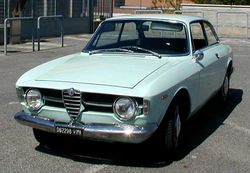 Alfa Romeo GT 1300 Junior, early model Alfa Romeo GT 1300 Junior, early model
| |
| Alfa Romeo 105/115 Series Coupé | |
|---|---|
| Manufacturer | Alfa Romeo |
| Production | 1963–1977 |
| Predecessor | Alfa Romeo Giulietta Coupé |
| Successor | Alfa Romeo Alfetta GT, GTV & GTV6 |
| Class | Sports Car |
| Body style | 2+2 Coupé 2+2 Cabriolet |
| Layout | FR layout |
| Engine | Straight-4 |
| Transmission | 5-speed manual |
| Fuel capacity | |
| Assembly | Italy (1965-1977) Rosslyn plant, South Africa |
| Related | Alfa Romeo Giulia Saloon |
| Similar | |
| Designer | Bertone |
The Alfa Romeo 105/115 series Coupés were a range of cars made by the Italian manufacturer Alfa Romeo from 1963 until 1977. They were the successors to the celebrated Giulietta Sprint coupé and used a shortened floorpan from the Giulia Berlina car. These appealing cars were made in a wide variety of models over a period of 13 years, so they provide a lot of material for study by Alfa Romeo enthusiasts.
Bodywork
The basic body shape shared by all models was designed by Giorgetto Giugiaro for Bertone. It was one of his first major projects for Bertone, and borrowed heavily from his earlier design for the Alfa Romeo 2000 Sprint/2600 Sprint. The balance of glass and metal, the influence of the shape of the front and rear glass on the shape of the cabin, and the flat grille with incorporated headlamps were groundbreaking styling features for the era.
A limited production (1000 units) convertible, the Giulia Sprint GTC, was a modification from the standard car by Touring of Milan, offered as a catalogue model by Alfa Romeo called the Giulia Sprint GTC.
A small number of the GT Junior models were also built with a very different, aerodynamic two-seater coupe body designed by Ercole Spada for Zagato of Milan. These too were offered by Alfa Romeo as catalogue models, as the GT 1300 Junior Zagato and later GT 1600 Junior Zagato.
Mechanical features
All models feature the four cylinder, all-light-alloy Alfa Romeo Twin Cam engine in various cubic capacities from 1290 cc to 1962 cc, all with two valves per cylinder. All versions of this engine fitted to the 105 series coupes featured twin carburettors, except for US market 1750 GTV and 2000 GTV cars which were fitted with fuel injection. Competition models featured cylinder heads with twin spark plugs. Common to all models was also a 5-speed manual transmission and disc brakes on all four wheels. The rear suspension uses a beam axle with coil springs. Air conditioning and a limited slip rear differential were optional on the later models.
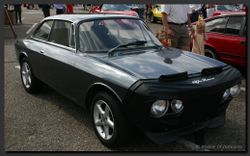
Models
| Version | Years of production | Units produced |
|---|---|---|
| Sprint GT | from 1963 to 1966 | 21,542 |
| Sprint GTC | from 1964 to 1966 | 1,000 |
| Sprint GTV | from 1965 to 1968 | 14,240 |
| 1750 GTV | from 1968 to 1973 | 44,269 |
| 2000 GTV | from 1971 to 1976 | 37,459 |
| GT 1300 Junior | from 1965 to 1977 | 91,195 |
| GT 1600 Junior | from 1972 to 1976 | 14,299 |
The 105 series coupés featured the GT (Gran Turismo) model description, which was common to all models in one form or another.
The various different models in this range can be considered in two broad categories.
On one hand were the various Gran Turismos and Gran Turismo Veloces (veloce is Italian for "fast"). These were meant to be the most sporting cars in the Alfa Romeo range and sold very well to enthusiastic motorists around the world. The first model available was the Giulia Sprint GT (1963) which evolved into the Giulia Sprint GT Veloce (1965), the 1750 GTV (1968) and the 2000 GTV (1972-1976), with engines increasing in cubic capacity from 1570 cc (Giulia Sprint GT/GTV) through 1779 cc (1750 GTV) to 1962 cc (2000 GTV). A limited production (1000 units) convertible, the Giulia Sprint GTC, was based on the Giulia Sprint GT, modified by Touring of Milan. It was only made over two years from 1964 to 1966.
On the other hand was the GT Junior range, which featured engines with smaller cubic capacities. GT Juniors sold in great numbers to people who wanted a sporting, stylish car that handled well, but either did not require the maximum in engine power, or could not afford the taxation on larger engine capacities in some markets - most notably, Alfa Romeo's home Italian market. Junior models began with the first GT 1300 Junior in 1966. The GT 1300 Junior continued until 1976 with the 1290 cc engine and various modifications incorporating features from the evolution of the GT's and GTV's. From 1972 a GT 1600 Junior model was also available, with the 1570 cc engine.
The 1300 Junior and 1600 Junior also became available with a very different, aerodynamic two-seater coupe body designed by Ercole Spada for Zagato of Milan. These models were the GT 1300 Junior Zagato and GT 1600 Junior Zagato.
Both categories were used to derive GTA ("Allegerita", or "lightened") models, which were specifically intended for competition homologation in their respective engine size classes. The GTA's featured extensive modifications for racing, so they were priced much higher than the standard models and sold in much smaller numbers. Practically all GTA's made were used in competition, where they had a long and successful history in various classes and category. These models included the Giulia Sprint GTA, GTA 1300 Junior, and GTAm (a much evolved version of the GTA built by Autodelta).
Although not commonly thought of as a 105 Series coupe variant, the Alfa Romeo Montreal used a strengthened and slightly modified 105 series floorpan and suspension.
GT and GTV models
Giulia Sprint GT (1963–1966)
Tipo: 105.02. Motore: 00502.
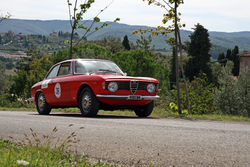
| |
| Giulia Sprint GT | |
|---|---|
| Manufacturer | Alfa Romeo |
| Production | 1963–1966 |
| Predecessor | |
| Successor | |
| Class | |
| Body style | 2+2 coupé |
| Layout | |
| Engine | 1570 cc dohc straight-4 |
| Weight | 948 kg |
| Fuel capacity | |
| Assembly | |
The Giulia Sprint GT was the first model introduced, and was manufactured from 1963 to 1966. It featured the original form of the Bertone body with the scalina (stepped) or "step front" (the leading edge of the hood/bonnet sat 1/4 an inch above the nose of the car). It can be most easily distinguished from other models by the following features:
- Badging: chrome script reading "Giulia Sprint GT" on bootlid, one round Alfa Romeo badge on the grille heart, Bertone badges behind the front wheelarches.
- Flat, chrome grille featuring a plain rectangular mesh with no bars.
- Single-piece chrome bumpers
- Dashboard with a flat, tilted panel finished in grey crackle.
The car was fitted with the 1570 cc displacement version of the engine (78 mm bore x 82 mm stroke, 6.38 L oil sump, 7.41 L radiator). Dunlop disc brakes were fitted all around. The rear brakes featured an unusual arrangement with the slave cylinders mounted on the axle tubes, operating the calipers by a system of levers and cranks. 31,955 Sprint GTs were produced.
Giulia Sprint GTC (1964-1966)
Tipo: 105.25. Right hand drive tipo: 105.29. Motore: 00502.
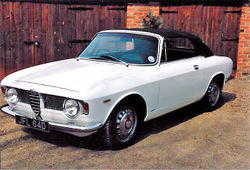
| |
| Giulia Sprint GTC | |
|---|---|
| Manufacturer | Alfa Romeo |
| Production | 1964–1966 around 1000 produced |
| Predecessor | |
| Successor | |
| Class | |
| Body style | 2+2 cabriolet |
| Layout | |
| Engine | 1570 cc dohc straight-4 |
| Transmission | |
| Wheelbase | |
| Length | 4080 mm |
| Width | 1580 mm |
| Height | 1315 mm |
| Fuel capacity | |
| Assembly | |
| Weight | 905 kg |
The Giulia Sprint GTC was a Cabriolet version produced in very limited numbers making them rare today with a total production of 1000 in right and left hand drive versions. The car was based on the Giulia Sprint GT, with the cabriolet modification carried out by Touring of Milan. Besides the cabriolet top, a distinguishing feature is the dashboard finished in black instead of grey crackle. The model was badged with a script reading "Giulia Sprint GTC" on the bootlid.
To restore some of the bodyshell rigidity lost by removing the fixed roof and pillars, Carrozzeria Touring added reinforcement to several areas of the bodyshell. Through the production life of the model, several modifications to the reinforcement applied were made by Touring, apparently in an effort to improve the stiffening achieved.
Carrozzeria Touring was in financial trouble when the Giulia Spring GTC went into production. The company went out of business shortly after production of this model ended.
Giulia Sprint GT Veloce (1965-1968)
Tipo: 105.36. Right hand drive tipo: 105.37. Motore: 00536.
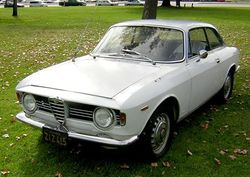
| |
| Giulia Sprint GT Veloce (GTV) | |
|---|---|
| Manufacturer | Alfa Romeo |
| Production | 1965–1968 |
| Predecessor | Giulia Sprint GT |
| Successor | 1750 GTV |
| Class | |
| Body style | 2+2 coupé |
| Layout | |
| Engine | 1570 cc dohc straight-4 |
| Transmission | 5-speed synchromesh |
| Wheelbase | |
| Length | 4089 mm |
| Width | 1575 mm |
| Height | 1321 mm |
| Fuel capacity | |
| Assembly | |
| Weight | 1012 kg |
The Giulia Sprint GT Veloce was very similar to the original Giulia Sprint GT. It featured minor modifications to the engine, providing just 3 bhp more power, but significantly improved torque. It can be most easily distinguished from other models by the following features:
- Badging as per Giulia Sprint GT, with two additions: Round enamel badges on the C-pillar with a Green quadrifoglio (cloverleaf) on an ivory background, and chrome "Veloce" script on rear panel.
- Grille with black mesh and 3 horizontal chrome bars.
- Dashboard with tilted flat panel as on the Giulia Sprint GT but with imitation woodgrain instead of grey crackle finish (first seen on the GT 1300 Junior).
- Front seats revised to a mild "bucket" design.
- Grille heart has 7 bars instead of 6.
- Stainless steel bumpers, as opposed to the chromed mild steel bumpers on the Giulia Sprint GT. The bumpers are the same shape, but made in two pieces (front) and three pieces (rear) with small covers hiding the joining rivets.
Early Giulia Sprint GT Veloces featured the same Dunlop disk brake system as the Giulia Sprint GT. Later cars replaced this with the ATE disk brakes as pioneered on the GT 1300 Junior in 1966. The ATE brakes featured an interesting and more effective handbrake system on the rear brakes, which incorporated drum brakes inside the disk castings.
A total of 14,240 Giulia Sprint GT Veloces were made before production finished.
| Alfa Romeo Giulia GTA Junior Gr.5 Racing |
|---|
1750 GT Veloce (1967-1971)
Tipo: 105.44. Right hand drive tipo: 105.45. Motore: 00548
U.S. tipo: 105.51. Motore: 00571.
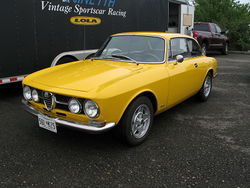
| |
| 1750 GT Veloce (GTV) | |
|---|---|
| Production | 1967-1971 |
| Body style | 2-door coupé |
| Engine | 1779 cc dohc straight-4 |
| Length | 4089 mm |
| Fuel capacity | 46L |
| Weight | 1038 kg |
| Height | 1321 mm |
| Width | 1575 mm |
| Wheelbase | 2350mm |
The 1750 GTV appeared in 1967 along with the 1750 Berlina sedan and 1750 Spider. The same type of engine was used to power all three versions; this rationalisation was a first for Alfa Romeo.
The 1750 GTV replaced the Giulia Sprint GT Veloce and introduced many updates and modifications. Most significantly, the engine capacity was increased to 1779 cc displacement (80 mm bore x 88.5 mm stroke, 6.61l oil capacity, 9.58l radiator capacity). Peak power from the engine was increased to 122 PS (90 kW; 120 hp)Template:Convert/test/Aon at 5500 rpm. The stroke was lengthend from 82 to 88.5 mm over the 1600 engine, and a reduced rev limit from 7000 rpm to 6000 rpm. Maximum torque was increased to Template:Auto Nm at 3000 rpm. A higher ratio final drive was fitted (10/41 instead of 9/41) but the same gearbox ratios were retained. The result was that, on paper, the car had only slightly improved performance compared to the Giulia Sprint GT Veloce, but on the road it was much more flexible to drive and it was easier to maintain higher average speeds for fast touring. For the United States market, the 1779 cc engine was fitted with a fuel injection system made by Alfa Romeo subsidiary SPICA, to meet emission control laws that were coming into effect at the time. Carburettors were retained for other markets.
The chassis was also significantly modified. Tire size went to 165/14 from 155/15 and wheel size to 5 1/2J x 15 instead of 5J x 15, giving a wider section and slightly smaller rolling diameter. The suspension geometry was also revised, and an anti-roll bar was fitted to the rear suspension. ATE disk brakes were fitted from the outset, but with bigger front disks and calipers than the ones fitted to GT 1300 Juniors and late Giulia Sprint GT Veloces. The changes resulted in significant improvements to the handling and braking, which once again made it easier for the driver to maintain high average speeds for fast touring.
The 1750 GTV also departed significantly from the earlier cars externally. New nose styling eliminated the "stepped" hood of the Giulia Sprint GT, GTC, GTA and early GT 1300 Juniors and incorporated four headlamps. United States market 1750 GTV's also featured larger rear light clusters. Besides the chrome "1750" badge on the bootlid, there was also a round Alfa Romeo badge. Similar Quadrofoglio badges to those on the Giulia Sprint GT Veloce were fitted on C pillars, but the Quadrofoglio was coloured gold instead of green. The car also adopted the higher rear wheelarches first seen on the GT 1300 Junior.
The interior was also much modified over that of earlier cars. There was a new dashboard with large speedometer and tachometer instruments in twin binnacles closer to the driver's line of sight. The instruments were mounted at a more conventional angle, avoiding the reflections caused by the upward angled flat dash of earlier cars. Conversely, auxiliary instruments were moved to angled bezels in the centre console, further from the driver's line of sight than before. The new seats introduced adjustable headrests which merged with the top of the seat when fully down. The window winder levers, the door release levers and the quarterlight vent knobs were also restyled.
Early (Series 1) 1750 GTV's featured the same bumpers as the Giulia Sprint GT Veloce, with the front bumper modified to mount the indicator / sidelight units on the top of its corners.
The Series 2 1750 GTV of 1970 introduced other mechanical changes, including a dual circuit braking system (split front and rear, with separate servos). The brake and clutch pedals on left hand drive cars were also of an improved pendant design, instead of the earlier floor-hinged type. On right hand drive cars the floor-hinged pedals were retained, as there was no space for the pedal box behind the carburettors. Externally, the series 2 1750 GTV is identified by new, slimmer bumpers with front and rear overriders. The combined front indicator and sidelight units were now mounted to the front panel instead of the front bumper. The interior was slightly modified, with the seats retaining the same basic outline but following a simpler design.
44,269 1750 GTVs were made before their replacement came along.
2000 GT Veloce (1971-1976)
Tipo: 105.21. Right hand drive tipo: 105.22.
U.S. tipo: 11501. Motore: 01500.
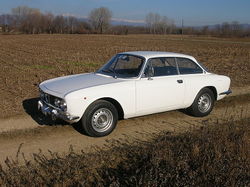
| |
| 2000 GT Veloce (GTV) | |
|---|---|
| Production | 1971-1976 |
| Body style | 2-door coupé |
| Engine | 1962 cc dohc straight-4 |
| Length | 4089 mm |
| Fuel capacity | 52.3 L |
| Weight | 1028 kg |
| Height | 1321 mm |
| Width | 1575 mm |
| Wheelbase | 2350 mm |
The 2000 GTV was introduced in 1971 together with the 2000 Berlina sedan and 2000 Spider. The 2000 range was the replacement for the 1750 range. Once again the engine was rationalised throughout the range. The engine displacement was increased to 1962 cc with a change of the bore and stroke to 84 mm x 88.5 mm. Oil and radiator capacities remained unchanged. The engine produced 132 PS at 5500 rpm with the SPICA fuel injection, which, once again, was only fitted to cars destined for the United States market, with carburettors retained for other markets.
The interior trim was also changed, with the most notable differences being the introduction of a single instrument cluster, instead of the gauges installed in the dash panel in earlier cars.
Externally the 2000 GTV is most easily distinguished by the following features:
- Grille with horizontal chrome bars, featuring protruding blocks forming the familiar Alfa heart in outline.
- Smaller hubcaps with exposed wheel nuts.
- Optional aluminium alloy wheels of the same size as the standard 5. 1/2J x 14 steel items, styled to the "turbina" design first seen on the alloy wheels of the Alfa Romeo Montreal. "Turbina" refers to the wheel's resemblance to a jet engine inlet.
- The larger rear light clusters first fitted to United States market 1750 GTV's were standard for all markets on the 2000 GTV.
37,459 2000 GTVs were made before production ended.
GT Junior models
GT 1300 Junior (1965-1977)
Tipo: 105.30. Right hand drive tipo: 105.31. Motore: 00530. Motore, 1974 on: 00530*S.
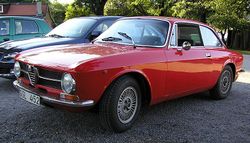
| |
| GT 1300 Junior | |
|---|---|
| Manufacturer | Alfa Romeo |
| Production | 1965-1977 |
| Predecessor | |
| Successor | |
| Class | |
| Body style | 2+2 coupé |
| Layout | |
| Engine | 1290 cc dohc straight-4 |
| Transmission | |
| Wheelbase | |
| Length | 4080 mm |
| Width | 1580 mm |
| Height | 1310 mm |
| Weight | 930 kg |
| Fuel capacity | 46 L |
The GT 1300 Junior was the entry model to the Alfa Romeo coupe range. It was introduced in 1965 as the replacement for the 101 series Giulia Sprint 1300, which was the final development of the Giulietta Sprint series.
The GT 1300 Junior was fitted with the 1300 (1290 cc) twin cam engine (74 mm bore x 75 mm stroke), as fitted to the Giulietta series cars, but revised for the 105 series with reduced port sizes and other modifications. The smaller engine was introduced in order to allow buyers to choose an Alfa Romeo coupe while avoiding the higher taxes on the models with larger engine capacity, especially in Alfa Romeo's home Italian market.
The performance was low-end compared to others in its model line, with a total of 89 bhp. However, the GT 1300 Junior's top speed of over 100 mph and 0-60 mph time of 12.6 seconds were very good for a fully-appointed coupe with an engine of only 1300 cc displacement.
The GT 1300 Junior was in production for over a decade. Throughout this period it was updated by the factory, incorporating many of the same revisions applied to the larger-engined models.
The first GT 1300 Juniors produced were based on the Giulia Sprint GT, with a simpler interior. The major external identifying feature was the black grille with just one horizontal chrome bar. The same 9/41 final drive ratio was maintained, but with a shorter 5th gear ratio of 0.85, instead of 0.79 as on all the other 105 Series coupes.
Together with the Giulia 1300 Ti, the GT 1300 Junior pioneered the use of ATE disk brakes as later fitted throughout the 105 series, replacing the Dunlop disks on earlier cars. The first few GT 1300 Juniors lacked a brake servo, and had the low rear wheelarches of the Giulia Sprint GT and Giulia Sprint GTV. From 1967, a servo was fitted as standard, together with higher rear wheelarches as adopted later on the 1750 GTV.
In 1968, concurrently with the replacement of the Giulia Sprint GT Veloce by the 1750 GTV, the GT 1300 Junior was revised with many of the new parts from the 1750 GTV. This included the dashboard, the suspension and the new wheel size. This revised GT 1300 Junior, however, retained the early "step-front" body style, which, interestingly, makes it the most mechanically refined production "step-front" model.
In 1970 the car was revised a second time, and received the same nose treatment as the 1750 GTV, without the step but with only two headlights.
For 1972, new wheels featuring smaller hubcaps with exposed wheel nuts like those on the 2000 GTV were fitted. At the same time, the GT 1600 Junior was introduced alongside the GT 1300 Junior. The GT 1300 Junior was discontinued for the right hand drive UK market but continued to be available in other right hand drive markets.
From 1974 the GT1300 Junior and GT1600 Junior were both rationalised with the 2000 GTV. See below.
GT 1600 Junior (1972-1976)
Tipo: 115.03. Right hand drive tipo: 105.05. Motore: 00536.
Tipo, 1974 on: 115.34. Motore, 1974 on: 00526/A*S.

| |
| GT 1600 Junior | |
|---|---|
| Manufacturer | Alfa Romeo |
| Production | 1972-1976 |
| Predecessor | |
| Successor | |
| Class | |
| Body style | 2+2 coupé |
| Layout | |
| Engine | 1570 cc dohc straight-4 |
The GT 1600 Junior was introduced in 1972, to plug the gap between the GT 1300 Junior and the larger-engined 2000 GTV. In the UK right-hand-drive market the GT 1300 Junior was dropped, but in many other markers the two models were available as a range. The engine was substantially the same as that of the Giulia Sprint GTV discontinued four years previously, and had the same engine type number. The final drive ratio was again 9/41 as standard on all 105 Series coupes with the 1290 cc and 1570 cc engine.
From 1974 on, the GT 1300 Junior and GT 1600 Junior was unified with the 2000 GTV, sharing most of the interior and exterior features with the larger-engined car. The only exterior differences were no bumper over-riders, lack of C-pillar green serpent badges, and GT 1300 Junior or GT 1600 Junior badge on the boot. Apart from the engine, mechanical differences were limited to the smaller front brakes, with the Juniors not adopting the larger units fitted to the 1750 GTV and 2000 GTV, and to the differential and (GT 1300 Junior only) 5th gear ratios.
The GT Junior has a tight suspension and weighed in at just 2050 lb. Because of this, the car would often go onto three wheels, lifting the inside front wheel off the road when driven enthusiastically.
Production ended in 1976 and totalled 80623 units.
GT 1300 Junior Zagato (1969-72) & GT1600 Junior Zagato (1972-76)
Tipo: 105.93. Motore: 00530. (1300).
The GT 1300 Junior Zagato was a limited production two seater coupe with aerodynamic bodywork by Zagato of Milan. The model evoked the earlier, race-oriented Giulietta Sprint Zagatos which featured aluminium bodywork and had a very active competition history. However, the Junior Zagato was not specifically intended for racing. It featured steel bodywork, and did not see much use in competition.
With the introduction GT 1600 Junior in 1972, a GT 1600 Junior Zagato was also introduced.
GTA models
Main Article Alfa Romeo GTA
Giulia Sprint GTA (1965–1969)
Tipo: 105.32 (Alfa Romeo), 105.02/A (IGM homologation).
Right hand drive tipo: 105.34.
Motore: 00502/A or 00532/A (identical save for no. prefix.)
The GTA retained the external form of the Giulia Sprint GT, but was constructed with aluminum external panels replacing the standard steel panels. The 'A' stood for "Alleggerita", Italian for "lightened". The engine was based on that of the standard 1600 cc car with a new, twin-plug head and Weber 45DCOE carburettors. The sump, camshaft cover, timing cover and clutch housing were in lightweight magnesium alloy instead of the standard aluminium alloy. Many other measures were also taken to lighten the car, and tune it for racing. All GTA's had the lower rear wheelarches as fitted to the Giulia Sprint GT's and GTV's, and very early GT 1300 Juniors. The GTA was available from the factory as a high-performance car for the road or racing. Unmodified cars in factory trim have come to be known as "GTA Stradale" but few were sold in this form. Most customers were racers and had them further modified and tuned before delivery by Autodelta, which had become a wholly-owned Alfa Romeo subsidiary running its competition department.
GTA 1300 Junior (1968-1973)
Tipo: 105.59. Motore: 00559.
The GTA 1300 Junior (Tipo 105.59) was based on the early step-front GT 1300 Junior, incorporating the same modifications as the GTA. Its engine was not based on the standard 1300 cc motor but was instead a GTA engine with the same bore but a shorter stroke (67.5 instead of 82 mm). Unlike the GTA, the GTA 1300 Junior featured the higher rear wheelarches as first seen on the GT 1300 Junior and later adopted for the 1750 GTV. Once again the GTA 1300 Junior was available as a standard car from Alfa Romeo, but most were modified by Autodelta for racing before delivery.
GTAm
| Alfa Romeo GTAm Hillclimb |
|---|
Unlike the Giulia Sprint GTA and GTA 1300 Junior, The GTAm was not built by Alfa Romeo, was never available from the factory and was never issued its own Tipo number. It was built by Autodelta and was based on the 1750 GTV. Once again the engine had a special cylinder head with twin spark plugs, but this time the head was to a new design departing significantly from the standard engine in having a much smaller included angle between the valves.
References
- Alfa Romeo Giulia Coupe GT and GTA, John Tipler, ISBN 1-903706-47-5
- Alfa Romeo GT 1300 Junior Instruction Book, Alfa Romeo
- Alfa Romeo Giulia, GT, Spider Owners Workshop Manual, Autobooks, ISBN 0-85146-128-X
- Alfa Romeo Production Cars 1910-1966, Stefano d' Amico and Maurizio Tabuchi, Giorgio Nada Editore, ISBN 88-7911-167-1
1967 Alfa Romeo Giulia Super 1600
- 65 3.jpg
- 99 3.jpg
- 96 3.jpg
- B3 3.jpg
- 25 3.jpg
- E6 3.jpg
- 3e 3.jpg
1969 Alfa Romeo Giulia 1300 Ti
- 1969 Alfa Romeo Giulia 1300 Ti 1.jpg
- 1969 Alfa Romeo Giulia 1300 Ti 2.jpg
- 1969 Alfa Romeo Giulia 1300 Ti 3.jpg
- 1969 Alfa Romeo Giulia 1300 Ti 4.jpg
- 1969 Alfa Romeo Giulia 1300 Ti 5.jpg
- 1969 Alfa Romeo Giulia 1300 Ti 6.jpg
- 1969 Alfa Romeo Giulia 1300 Ti 7.jpg
External links
| <- Previous | Alfa Romeo Automobiles S.p.A., a subsidiary of the Fiat S.p.A. since 1986, car timeline, 1946-1979 | Next -> | ||||||||||||||||||||||||||||||||||||||||||
| Type | 1950s | 1960s | 1970s | |||||||||||||||||||||||||||||||||||||||||
| 0 | 1 | 2 | 3 | 4 | 5 | 6 | 7 | 8 | 9 | 0 | 1 | 2 | 3 | 4 | 5 | 6 | 7 | 8 | 9 | 0 | 1 | 2 | 3 | 4 | 5 | 6 | 7 | 8 | 9 | |||||||||||||||
| Small family car | Dauphine* | Alfasud | ||||||||||||||||||||||||||||||||||||||||||
| Compact executive car | Giulietta (750/101) | |||||||||||||||||||||||||||||||||||||||||||
| Giulia | Giulietta (116) | |||||||||||||||||||||||||||||||||||||||||||
| 1750 | Alfetta | |||||||||||||||||||||||||||||||||||||||||||
| Executive car | 1900 | 2000 | 2600 | 2000 | Alfa 6 | |||||||||||||||||||||||||||||||||||||||
| Cabriolet | 1900 | 2000 | 2600 | |||||||||||||||||||||||||||||||||||||||||
| Coupé | Giulietta | Sprint | ||||||||||||||||||||||||||||||||||||||||||
| Giulia | Alfetta GT/GTV and GTV6 | |||||||||||||||||||||||||||||||||||||||||||
| 1900 | 2000 | 2600 | ||||||||||||||||||||||||||||||||||||||||||
| Roadster | Spider | |||||||||||||||||||||||||||||||||||||||||||
| Gran Sport Quattroruote | ||||||||||||||||||||||||||||||||||||||||||||
| Sports car | …6C 2500 | Montreal | ||||||||||||||||||||||||||||||||||||||||||
| 33 Stradale | ||||||||||||||||||||||||||||||||||||||||||||
| Off-road | Matta | |||||||||||||||||||||||||||||||||||||||||||
| Racing car | TZ/GTA | |||||||||||||||||||||||||||||||||||||||||||
| …158/159 | Tipo 33 | 177 | ||||||||||||||||||||||||||||||||||||||||||
| *Dauphine was produced under Renault license | ||||||||||||||||||||||||||||||||||||||||||||
